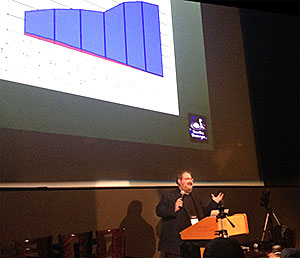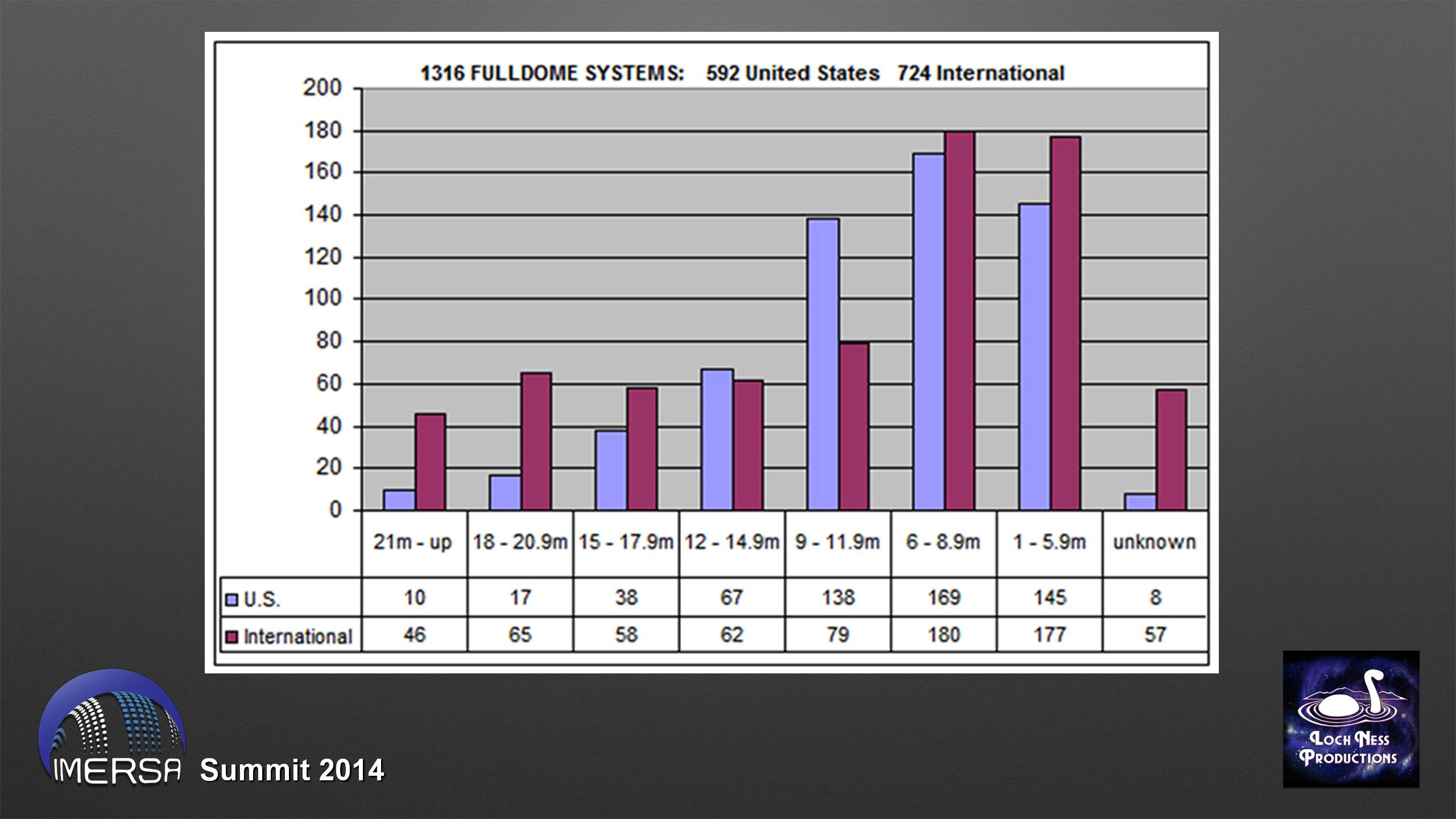The 2014 State of the Dome Address
by Mark C. Petersen, Loch Ness Productions
A presentation for the IMERSA Summit,
Denver, Colorado, March 2014
As perspective for pondering the future of fulldome as a medium and market, it is useful to review its current state. Statistics drawn from Loch Ness Productions' DOME THEATER COMPENDIUM are presented and discussed, and provide some answers to the quintessential questions: "Who are we, where are we, and what are we doing?"
Ladies and gentlemen, it's raining soup — grab a bucket!
By that I mean there's a wealth of information about our fulldome industry online. Those of you who have heard me present in previous years already know that Loch Ness Productions curates two extensive fulldome databases — one for theaters, and one for shows. I'll summarize some salient points from these resources.
So what is the state of the dome? How is the fulldome industry doing?
When you ask "How are you doing?" or "How's business?" the answer depends on who you're asking — where they're coming from.
Those in the biz basically fall into three categories:
- There are the theaters — those places with the domes.
- There are the hardware vendors — those who sell the domes and the equipment that goes into them.
- And there are the content providers — those who sell the stuff that gets shown in the domes.
Sure, there is some overlapping — some theaters create their own content, some hardware vendors also produce shows. But in general, you're going to be primarily one of the three.
Let's take planetarium theaters first. You already have access to the same raw data I have, because we publish it on our Web site: the LNP Fulldome Theater Compendium. It's under the Reference tab on every page.
When you go there, you select the country you want to look at, and then just scroll through the listings we have. Where they are, what equipment they have, the staffpeople to contact — they're all there for the viewing. When I captured this page, there were 1,225 locations, with just under half of those in the US.
I compiled this graph from looking over my previous State of the Dome presentations. This is the growth of our industry; it counts the fulldome systems installed out there. In 2007, there were 316; six years later, there are a thousand more. Up and up and up, a rosy picture, right? Well, you can see the pace of growth is slowing. In each of the previous years, I'd added more than 100 fulldome installations; last year for the first time, there were fewer — only 78. Whether this means growth will eventually level off or decline or accelerate again... well, my crystal ball is rather murky. My guess is that we're reaching market maturity — everyone who wants a fulldome system has one already, or they'll be getting it when their budgets allow.
There's a new figure this year, that thin little area in purple. I do keep track of the year the institutions that run these theaters opened. And from this we can tell how many are brand-new start-from-scratch theaters, as compared to those who have just added fulldome or upgraded a theater that's been around for awhile. From a high of 52 in 2008, that number has steadily declined over the years — down to the point where there's only one a month — one fresh-from-the-ground-up new theater opening anywhere in the world.
So there's a dichotomy. If you're selling fulldome systems, it's been all good, and things continue to look rosy. In previous years, I used to tally up who had sold how many systems. We're at the point where all the major players in the market have each sold hundreds of systems. On the other hand, if you're an architect or a hardware vendor who designs new theaters, it looks like the opportunities to ply your trade are few and far between, and diminishing.
Now if you're a content provider, you may look at the increasing numbers and think there's a growing market for your work. Well, let's look more closely at these theaters. These next few demographics haven't changed much over the years.
This is the breakdown of those fulldome systems by the size of their domes. The US has more mid-size domes than internationally, but everywhere else there are more large and small domes than there are here.
Of note are the really big theaters — those with a 21-meter or bigger dome. I count only 10 in the US. We've heard the word "convergence" quite a bit at this conference, from the Giant Screen Cinema Association folks. Well, there simply aren't many giant screen domes to converge onto. 4 of the 10 we list were already giant-screen theaters before they went fulldome.
There are more places than not that have their audiences actually facing the content they present. Can you imagine — there are those theaters that don't? And they want to know why shows aren't produced with their seating in mind.
The institutions that run fulldome theaters are almost ALL educational in nature. Whether they're in a school or a school district, a university or college, a museum or science center — their primary mission is to provide enlightenment to the masses — not necessarily entertainment. And of course, if it says "Planetarium" on the wall outside, people expect to find astronomy stuff happening on the inside.
This can be a problem for those of us who create and distribute shows. We sometimes hear the question "Why isn't there more non-astronomy fulldome content out there?" Well, when a planetarium presents non-astronomy content, they're often working at odds to their own mission statements of astronomy education. They may express interest in non-astronomy content, but that doesn't necessarily mean they'll be sending their purchase orders for it.
Which brings us to content providers — what they provide, and how they can sell it.
This data is yours too — we've been curating it for years now, and it's a very popular online resource — the LNP Fulldome Show Compendium.
Go there and you find pretty much every show that's on the market today. We do highlight — in green — the shows that Loch Ness Productions distributes. It is our Web site, after all. But if we don't distribute a show, we still list it, and provide links to the producer's Web page for the show. Want to see a preview? Click the "View" button, and it opens a window with the preview that's on YouTube or Vimeo. Want to know how much the license costs? Click on the "Prices" button, and it takes you to our show's "Ordering" page. Of course this only works for shows in our catalog.
You just scroll through the list to find what you're looking for. The columns are sortable — if you're looking for the newest shows, click on "YEAR" and the screen redraws with shows in reverse chronological order; new shows will be at the top. Looking for a show that's less than 20 minutes? Sort by Duration and scroll. Looking for kiddie shows? Sort by Audience. Looking for non-astronomy content? Well, good luck with that.
There are nearly 300 commercially-available show titles in our database. If you sort those by genre, you'll see the overwhelming number are in the "Earth/Space" category. That hasn't changed from previous years either.
This chart includes what I presented at the 2013 IMERSA meeting for comparison. Since last year, I've added 19 Earth/Space titles... and 4 others. So that's 23 shows in a year, or basically 2 titles a month that come on the market. How long this pace will continue — or if it will go up or down — remains to be seen. I'm guessing it's not going to go up. The reason for that is simple: it's the economy.
And that brings me to the subject of fulldome show pricing. This is the very essence on our business... and we don't know if the business model for licensing fulldome shows is even viable. The issues are many, and there are strong opinions about the way things are being done.
I sat down to write my take on the subject of pricing; I eventually got 12 pages of dense text whittled down to 6. You can find my essay on fulldome show pricing on our blog; I hope you'll take some time to read it.
Some important issues are these: good shows are expensive to produce, and it's not clear that production costs can be met from licensing income. Movies are distributed, but planetariums are not run like movie theaters — indeed, some operators bristle at the very thought of being considered as a theater. That's why I put "Planetarium (theaters)" in the first slide. They say, "Dammit Jim, I'm a planetarian, not a projectionist!" They fear for their job security; that they can be replaced by someone who only needs to hit the "play" button. These are our customers — not all, but the sentiment is shared by some.
Budgets are always a challenge in educational institutions, and planetarians are notorious for being penurious. Moreover, they're being paid to teach astronomy, and often the shows they got with their fulldome systems meet their needs well enough, along with the planetarium software. They're not all crying for more and more content.
I was talking to Dan Neafus about kid's shows. He said to me, "For them, I've got One World, One Sky and The Little Star That Could. I can run these forever. I'm set. I really don't need anything else." Not much of a growth market for producers there.
Have we producers done ourselves in by offering 15-, 20- or 50-year licenses? We have some customers say, "I don't want a show for 50 years, I only want it for a weekend." But then they expect to pay less than it costs for us to ship it to them. We can't take the Wal-Mart approach, and hope to make it up in volume. You know how many fulldome theaters there are.
There are those who say we shouldn't license our shows for that long, that they should expire, then people will have to buy more. Well, we don't have any practical fulldome DRM, no way to stop a theater from running a show with an expired license. Planetariums aren't used to working that way. And even if we did, that wouldn't give planetariums increased budgets to buy more shows.
That's why free shows are so popular. You go to some theater's Web sites, and you see their entire show offerings consist of "Two Small Pieces of Glass", IBEX, "Dark", "Back to the Moon For Good", and maybe even Losing the Dark. You know they have no budget to buy any shows; they're only running the ones they got free. And maybe the shows that came bundled with their system when they bought it.
I don't have a chorus of angels ending prepared, but I'll finish with this thought. With 300 shows on the market, and "Earth/Space" the popular genre, how many more shows can the field support? How many more will the customers need? Let's say you want a show about exoplanets. There are six to choose from — we just added Albedo Fulldome's show called Extrasolar Planets to our own catalog. Want a show about black holes? There are three with "Black Holes" in their title, and more that include the topic. Want a tour of the solar system? The chances are good your fulldome system was installed with several already.
We may be reaching a saturation point for show content and titles — at least with those who actually buy content. My crystal ball is murky there too.
Check out the databases yourself. Make bookmarks to these pages. Send me updates, please. I'm doing this for you.
If you find this information useful, you can help support our efforts. Please go here or here or here.












